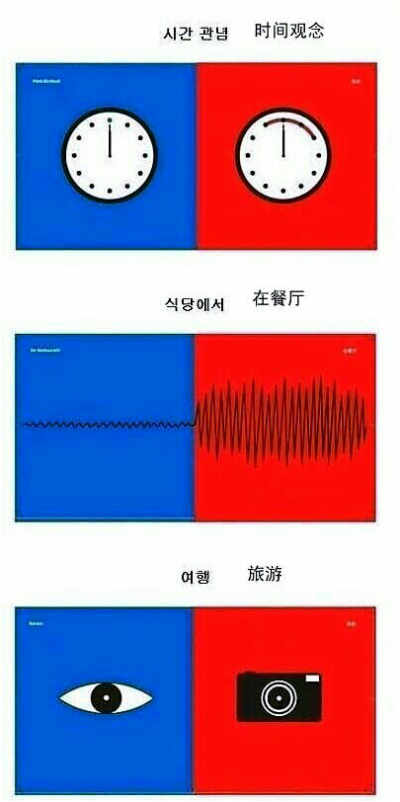The study of a language is never an “island unto itself” but rather comes as part of a package involving an entire culture and worldview which has evolved with over centuries and milennia. The worldview must be, and inevitably is, learned in parallel with a language. It is possible to learn the culture without the language, but it is more profound when learning the language. Plus you can communicate with natives on their own terms.
One benefit of studying Korean more-or-less full time over the past year has been the clarifying and/or opening up of such a new perspective to me, beyond what I understood about Korea, and East Asia generally, before.
(see, e.g., post #261 “But Which Twin is the Elder?”).
Here is a possible example of this. A Chinese native speaker in my Korean class sent me a set of paired images delineating differences between West and East and asked for comment. Simple pictures, simple headings, but not all have clear meanings.
I think it’s well done and thought provoking. The important thing is that this was produced by East Asians in East Asia, probably Chinese. It was found on a Chinese website.
Blue is Westerners. Red is Easterners:

인간 관계: Connections Between People
나(자신): Myself
문제 대처방식: Coping with Problems
인간 관계, Connections Between People: I am not sure exactly how to interpret this. Asians have a wider network of acquaintances whom they can rely on for favors? Westerners have fewer people they can rely on?
나(자신), Myself: Westerners have higher self esteem (maybe excessive). Asians tend to be internally nervous and self-conscious.
문제 대처방식, Coping with Problems: Like one of those ink blot tests, many things are possible to see here, too. Asians avoid problems rather than dealing with them as they should? Or is it that Asians smartly go around problems while we foolhardedly and obliviously plow on into them?

시간 관념: Concept of Time
식당에서: At the Restaurant
여해: Trip
시간 관념, Concept of Time: I’m not sure what this means. Westerners live in the moment? East Asians are smarter about managing time? I am reminded of the famous experiment that offers kindergarten students the choice of one chocolate treat now or two at some specified time in the future. More Asians would choose to wait and get two rather than dive in and enjoy just one immediately.
식당에서, At the Restaurant: Asians are louder at restaurants. Or, Asians have more fun at restaurants?
여해, Trip: Even before the rise of the digital- and now the smartphone-camera, this was the stereotype about Asians.

의사 소통: Doctor’s Communication
줄서기: Waiting in Line
파티: Party
의사 소통, Doctor’s Communication: I don’t know much about doctors in East Asia, having rarely been. My one impression was that doctors in Korea were quite rude, abrupt, and even arrogant, which was bizarre because U.S. doctors generally take pains to at least appear as approachable as possible.
줄서기, Waiting in Line: Japanese do not do this, but Chinese do, and Koreans are somewhere in the middle. It is interesting that whoever made this set of images equates “the West” with Ordentlichkeit and respect for rules in public like lining up neatly. This means “The West” is actually Northwest Europe and its overseas extensions (like the USA). Southern Europeans don’t form prim lines like this while waiting. (The “Italian queue”).
파티, Party: The Blue party looks much more fun.

서로에 대한 인식: Perception of Each Other
서로에 대한 인식, Perception of Each Other: This is a strange one.
Anger:
Western direct expression of emotions vs. Eastern “Saving Face”. Westerners would view a fellow Westerner who acts like the Red character (hiding actual emotions and pretending to feel the opposite way) with suspicion and even contempt.
Weekend: Yes. This really hits home. I have known many Westerners in Korea and Asia who don’t like going places among throngs of people all the time. Many complain and cannot handle it. We evolved in lower density environments. I am totally on the Blue side here. This was one of the hardest things to get used to for me in Korea.
Lifestyle: Right, but I do think Asians fundamentally misunderstand the Western side of this. From conversations with Koreans, it seems there is an idea that Western individualism means extreme selfishness, a complete disregard for the well-being of others. This might be a reasonable assumption. In reality, the results seem to be the reverse. Americans and other Westerners are very much open to strangers, help them when in need, and are kind and friendly to them for no reason. The irony is that Asians’ group thinking is that though they take care of the people in their group, they are a lot less open to outsiders.
Eating: I don’t understand. Does it mean Breakfast-Lunch-Dinner? Does it mean three “courses” within a meal? Does it just mean general eating habits (Westerners eat twice as much cold food as hot)?
Boss: Right. Maybe not quite right. The Blue character should be slightly bigger.





